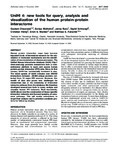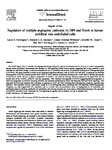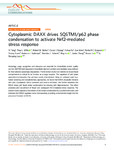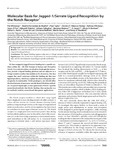UniHI 4: new tools for query, analysis and visualization of the human protein–protein interactome
| dc.contributor.author | Chaurasia, G | |
| dc.contributor.author | Malhotra, S | |
| dc.contributor.author | Russ, J | |
| dc.contributor.author | Schnoegl, S | |
| dc.contributor.author | Hänig, C | |
| dc.contributor.author | Wanker, EE | |
| dc.contributor.author | Futschik, Matthias | |
| dc.date.accessioned | 2017-02-07T19:50:10Z | |
| dc.date.available | 2017-02-07T19:50:10Z | |
| dc.date.issued | 2009-01 | |
| dc.identifier.issn | 0305-1048 | |
| dc.identifier.issn | 1362-4962 | |
| dc.identifier.uri | http://hdl.handle.net/10026.1/8408 | |
| dc.description.abstract |
Human protein interaction maps have become important tools of biomedical research for the elucidation of molecular mechanisms and the identification of new modulators of disease processes. The Unified Human Interactome database (UniHI, http://www.unihi.org) provides researchers with a comprehensive platform to query and access human protein-protein interaction (PPI) data. Since its first release, UniHI has considerably increased in size. The latest update of UniHI includes over 250,000 interactions between approximately 22,300 unique proteins collected from 14 major PPI sources. However, this wealth of data also poses new challenges for researchers due to the complexity of interaction networks retrieved from the database. We therefore developed several new tools to query, analyze and visualize human PPI networks. Most importantly, UniHI allows now the construction of tissue-specific interaction networks and focused querying of canonical pathways. This will enable researchers to target their analysis and to prioritize candidate proteins for follow-up studies. | |
| dc.format.extent | D657-D660 | |
| dc.format.medium | Print-Electronic | |
| dc.language | en | |
| dc.language.iso | eng | |
| dc.publisher | Oxford University Press (OUP) | |
| dc.subject | Computer Graphics | |
| dc.subject | Databases, Protein | |
| dc.subject | Humans | |
| dc.subject | Protein Interaction Mapping | |
| dc.subject | Proteins | |
| dc.subject | Software | |
| dc.subject | User-Computer Interface | |
| dc.title | UniHI 4: new tools for query, analysis and visualization of the human protein–protein interactome | |
| dc.type | journal-article | |
| dc.type | Journal Article | |
| dc.type | Research Support, Non-U.S. Gov't | |
| plymouth.author-url | https://www.webofscience.com/api/gateway?GWVersion=2&SrcApp=PARTNER_APP&SrcAuth=LinksAMR&KeyUT=WOS:000261906200117&DestLinkType=FullRecord&DestApp=ALL_WOS&UsrCustomerID=11bb513d99f797142bcfeffcc58ea008 | |
| plymouth.issue | suppl_1 | |
| plymouth.volume | 37 | |
| plymouth.publication-status | Published | |
| plymouth.journal | Nucleic Acids Research | |
| dc.identifier.doi | 10.1093/nar/gkn841 | |
| plymouth.organisational-group | /Plymouth | |
| plymouth.organisational-group | /Plymouth/Faculty of Health | |
| plymouth.organisational-group | /Plymouth/Users by role | |
| dc.publisher.place | England | |
| dc.identifier.eissn | 1362-4962 | |
| dc.rights.embargoperiod | Not known | |
| rioxxterms.versionofrecord | 10.1093/nar/gkn841 | |
| rioxxterms.licenseref.uri | http://www.rioxx.net/licenses/all-rights-reserved | |
| rioxxterms.type | Journal Article/Review |





